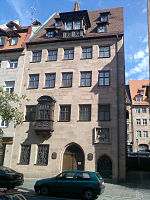Praunsches cabinet
The Praunsche Kabinett was a famous private collection in Nuremberg that existed from 1616 to 1801. Parts of this collection are now kept in museums in Berlin , Budapest ( Museum of Fine Arts ), Dresden , Copenhagen , London , Los Angeles , Munich , Nuremberg ( Germanic National Museum ), Paris and Washington, DC .
history
The merchant Paulus II. Praun (1548–1616) founded this collection in Bologna; he had inherited an art chamber from his father , the works of art of which he was able to integrate. He enriched the collection with numerous old German and Italian paintings from the 16th century.
In his will, Praun decreed that the art collection, together with the foundation house, the household effects, capital and income as an advance , a special legal form of Nuremberg inheritance law, should be inseparably preserved and expanded. After his death, the collection was transferred to the Praunsche Stiftungshaus in Nuremberg and exhibited.
A handwritten inventory from 1616 is preserved in the Nuremberg City Archives; an inventory from 1719 shows that the holdings had not been reduced until then, but only increased very modestly. Goethe was able to inspect these holdings in 1797.
As early as 1772, the family decided to largely separate from the collection and had Gottlieb von Murr compile a directory. In 1801, when the Institut der Vorendung no longer had any binding force, the family sold most of the items in the collection to the art dealer Johann Friedrich Frauenholz (1758–1822) due to economic hardship ; the resale to collectors extended over the following decades.
The part of the graphic acquired by Duke Franz Friedrich Anton von Sachsen-Coburg-Saalfeld is now in the copperplate cabinet of the Veste Coburg . The drawings, which Prince Miklos Esterhazy acquired almost entirely, are now kept in the Museum of Fine Arts in Budapest. Many of the other plants can also be located. A lidded cup in the shape of a pear from 1576 is still on loan from the Friedrich von Praun'schen Family Foundation in the Germanisches Nationalmuseum in Nuremberg, as are the portraits of councilor Stephan II. Praun (1513–1578) and his wife Ursula Ayrer (1525–1592) from Nicolas Neufchâtel (1568). The museum also owns the votive picture of Stephans I. Praun by Paul Lautensack (1511) and the portrait of the diplomat Stephan III. Praun (1544–1591) as a Santiago pilgrim as well as the hat and two coats of his pilgrim costume for the Way of St. James .
The whereabouts of most of the pieces is unknown.
scope
The collection, which comprised around 10,000 objects, was largely completed during the collector's lifetime and was largely limited to the classical genres.
- Painting: 250 works by German and Italian artists
- Drawing: 600 sheets mainly by German and Italian artists of the 16th century
- Prints: 6,000 copperplate engravings, including Albrecht Dürer's entire graphic work
- Sculpture: 300 sculptures (over one hundred miniatures of works mainly by Italian sculptors, made by Johan Gregor van der Schardt .)
- Books, coins, stones and precious stones
- Rarities: A smaller collection of rarities only played a subordinate role within the overall collection
literature
- The Praunsche Cabinet. Masterpieces from Dürer to Carracci. Exhib. Germanisches Nationalmuseum, Nuremberg 1994.
- Daniel Hess: Dürer as a Nuremberg branded article . in Hermann Maué u. a. (Ed.) Quasi the center of Europe: Europe buys in Nuremberg. Nuremberg 2002, pp. 451–464 (PDF)
- Rainer Schoch : The Praunsche Cabinet. An art collection as a »advance«. In: Anette Scherer (Red.): Patrons, donors, donors. The Germanic National Museum and its collections. Nuremberg 2002 (= cultural-historical walks in the Germanisches Nationalmuseum , vol. 5), pp. 47–52.
Individual evidence
- ↑ Praunsche pear ( pear cup with lid), in the object catalog of the GMN
- ↑ Stephan II. Praun (1513-1578) and Ursula Praun born. Ayrer (1525-1592) , in the object catalog of the GMN
